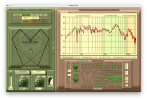I tested ORC in the last couple of hours. My setup: Mac mini -> Motu M4 -> Classe M600 -> Magico S5 II
For DRC I use Accourate generated, full range filters in BACCH via the HAFConvo VST3 plug-in.
First, some comments on the set up. I probably could have set it up myself, but for some reason the activation code was not arriving, so Edgar Choueri activated it remotely (great service as always). BACCH is easier if you use the default Babyface, but once you get the flow, that's good.
ORC is generated by measuring the typical sine sweep with the binaural mic on. My settings can be seen from the picture below
View attachment 353063
Here is the ORC window with the freq response (notice: this is mics in my ears, so not a free mic). First window shows my frequ response, second the target. You can change the target curve, default is Katz, which is quite flat. My preference is Olive with a bass tilt. My Accurate target curve is similar.
You can recompute the filter on the fly :
View attachment 353077
View attachment 353067
The best for me is to first test any effect with pink noise from Chesky's Best and then Warnes' Bird on a Wire.
During playback you can bypass BACCH (it compensates for the DRC gain loss) and can switch on/off ORC.
Observations:
- uBACCH gives already very good results. My room is symmetric, BACCH audiophile adds another 10degree of stage width. That was the same with version 13 (pre-ORC).
- It's hard to compare my vs ORC filters. because my FIR filters reduce volume by 6dB, means adjusting the dial after switching
- ORC either uses short FIRs or IIRs. Switching ORC on/off is immediate vs. the 0.3sec when switching to my 65k trap FIR.
- ORC with Katz filter changes pink noise to a whiter noise. The Olive filter is more what I would expect from a pink noise.
- The interesting effect of ORC is that it makes the sound richer and more brilliant, giving more atmosphere to instruments and voices, whereas my Accurate filters indeed a more neutral and dry. Kick drums sound more "into the stomach" with ORC and more like a smack with accurate.
More trying is needed for sure. It's great to have both options. It would be great to understand, what filters ORC is actually generating (FIR???) and how it actually treats the 3 frequency domains.
A great option is, that you can use head tracking with ORC, which means you can compensate the bass/room mode differences when moving your head. Haven't tried that yet.

